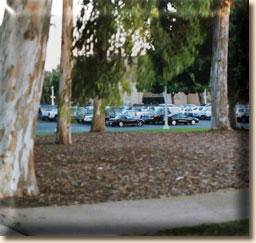- Above is a true picture of a tree's root system & how it extends out.
- Up to 35% of a tree's biomass is underground.
- Most roots grow closer to the soil surface than you think. Sometimes within the top 6 inches.
- When space is available, roots will extend out 2 to 3 times the reach of the branches.
- Roots absorb nutrients & water, store carbohydrates, & stabilize a tree's trunk & canopy.
- Growth regulators, produced in the roots, affect growth in the upper part of a tree.
- Studies show that 75% of a plant's potential for survival depends upon the root system.
The roots of the above eucalyptus start to grow up the bank, then grow out & down the slope.
This is the way roots grow on steep slopes. This is why large trees on steep slopes fail.
Roots grow sideways and
then down banks.
They do not grow straight into
the bank because of nutrional
requirements (oxygen, water,
etc.). They also do not grow
very far up a bank. This is due
to geotropism, which is the gravitational
effect on growth regulators within the
roots.That is why roots grow down.
The roots that “hold” a tree up grow in the opposite direction. Therefore, they actually
“pull” a tree up.
With no roots going into the
bank, but rather down, you see most tree failures, on steep
banks, fall in the lower 180 degrees of the slope. So do not allow trees on slopes to get too
big or better yet, plant trees
that don't grow as large.
Check it out next storm!
An unhealthy root system increases tree stress
making the tree more susceptible to disease & insects.
GRASS & TREES
- Grass & trees do not thrive together in nature.
- Turf can reduce the amount of tree roots in topsoil by 90%.
- A tree with an underdeveloped root system will;
- be slower growing,
- predisposed to certain insect and disease problems as seen in the picture (right),
- have a shorter life span.
MULCH
Organic mulch is possibly the best and least
expensive soil enhancer around. This is the way
nature does it, as a tree mulches its own root
system, returning nutrients to the soil.
A mulch covering should be 2 to 4 inches deep
and extend outside the dripline.
Decomposing mulch may be all the
nutrients your tree will ever need.
Mycorrhizae
Mycorrhizae are fungi that form a symbiotic relationship with the root system of a plant. Mycorrhizae:
- increase the absorbing capacity of roots up to 700%,
- mycorrhizae are also able to access water in micropores in soil that are too small for roots. This is a survival strategy for many native oaks growing on decomposed granite slopes,
- increase a roots tolerance to drought, high soil temperatures, and a variety of soil toxins, high salinity, & heavy metals,
- It is more efficient for a tree to support mycorrhizae than to produce the equivalent amount of roots.

Above, the hyphae or fungal strands
of the mycorrhizae are growing out of the root. These
strands absorb nutrients & water from the soil for the
roots in exchange for carbohydrates from the roots.
Mycorrhizae are part of a healthy root system.

If you see this fungal growth
in your yard, that's good. This
is the reproductive body of the mycorrhizal
fungus, deadman's foot, Pisolithus tinctorius.
WATERING
- The top 8‑12 inches of soil should be kept evenly moist within and just outside the dripline.
- Water should be applied slowly (without run‑off) within and just outside the dripline.
- Established trees only need to be watered every two to four weeks depending on the species and assuming watering was done as noted above.
Extremely dry soil causes hair root & mycorrhizal death, reducing the
tree roots' ability to absorb water long after the soil is re‑moistened.
If you still have questions, please call us at 619‑443‑1775.
We want our clients to be educated about their trees.







